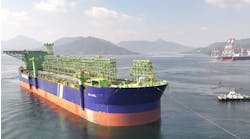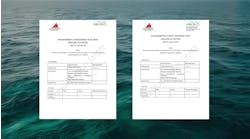New 'in-line' riser tensioning system
A new direct connecting design from Westech Heavy Machinery Div. (formerly Western Gear Corp.) not only simplifies the riser tensioning system, but also allows the riser and BOP to be "hung off" and left in the water, instead of being pulled to allow for other "critical path" activities. The Slip Joint Tensioner replaces the traditional series of hydraulic rams, cables, and turndown sheaves normally associated with riser tensioning systems.
This integrated unit combines radial manifold and six, long-stroke, hydraulic cylinders arrayed around a standard telescopic joint, all of which can be run, pulled, and laid down like a typical joint of riser. This design is integrated with a diverter housing and a trolley system installed just below the drill floor.
The SJT is made up into the top of the riser string, then landed below the diverter housing. The SJT is then stroked out to land the BOP and compensate for vessel heave and horizontal offset. Hydraulic power is provided by air/oil accumulators located below the drill floor area.
When it is time to run a christmas tree or other appliance, the BOP is disconnected, the SJT system retracted, and the entire SJT/riser string moved off the critical path. This is accomplished using the trolley system, which travels along two spider beams. This design clears the moonpool for the christmas tree to be run.
Once the tree is landed, the trolley moves the riser back into place, the slip joint tensioner is again stroked out, and the BOP landed on the tree. To pull the BOP, the riser and LMRP system can be hard hung off, moved from the critical path and a heavy-wall drillpipe string run to retrieve the BOP. Additionally, by pulling a number of riser joints, the BOP can be hung off further from the seabed for situations where the rig is traveling between well sites.
Using this in-line system has other advantages. Because the SJT is self-contained, it can be pulled and laid down for inspection and maintenance on the deck. The tensioning system design features uniform pulling force around the slip joint to reduce the wear on the hydraulic seals and rods. The initial design has a capacity of 3.5 MMlb and a stroke length of 65 ft. This design is applicable to deepwater operations, where pulling a riser string can take up to 72 hours in each direction. Westech HMD is a Control Flow Inc. company.
KOP opens umbilical facility
Aker Kværner company Kværner Oil-field Products plans to open a steel-tube umbilicals plant at the Middle Bay Port facility outside of Mobile, Alabama. The company hopes to leverage the experience it has gained at its existing facility in Moss, Norway, to break into the Gulf of Mexico market. The key to this new facility is its proximity to the deepwater GoM. By locating in a port facility, the company can save on transportation and load-out costs, making its products more competitive. The dock on this facility features a 600-ft-long pier on the 40-ft-deep Theodore Ship Chan-nel. This is located near a 1,100 ft-wide turning basin that is in 60-ft water depth. This means large container vessels will have easy access to the giant spools of umbilicals the plant will produce. The site is currently being upgraded with specialty equipment with an eye toward beginning operations in March 2003.
In addition to steel tube umbilicals, the facility will be designed to accommodate the manufacture of Aker Kværner's integrated production umbilical.
Ring drive cuts trip time
RD Drilling, a small company out of Indiana, has patented a ring-drive drilling system that could save a substantial amount of tripping and running time. Owner William J. Meiners said the design is similar to a conventional top-drive system, but has a removable core at the center.
The core, when in place, connects the outer drive of the system to the drillstring, providing the torque needed to turn the drill bit, as well as the connections for circulating drilling fluids. With the core removed, stands of drill pipe can be run through the center of the drive, then broken out and laid back. On a conventional system, the drive must pull the stand up from the drill floor so the slips can lock it in place. Then, the iron roughneck breaks out the pipe and lays it back. The top drive is lowered to the drill floor, where it grabs the next stand and repeats the process.
RD Drilling hopes to eliminate the time that the top-drive stands idle. Using the ring-drive system, the stand of pipe would be pulled, the slips dropped and then the top-drive, with the core removed, would lower around the stand of pipe. While the ring-drive is being lowered, the stand can be broken out, vertically lifted to clear the lowering ring-drive, and laid back. When the ring-drive reaches the drill floor, it can immediately grip the drill string to pull the next stand. With a properly designed and functioning system, the ring-drive can be continuously raised and lowered with no waiting during tripping in and out cycles. A drillship operator estimated a 50% reduction in tripping time for one of their drillships using a ring drive.
Well designed ring drive systems can also provide other benefits, such as fewer occurrences of stuck pipe due to less idle time when adding new pipe during drilling, and fast connection times to start drilling fluid circulation when tripping.
The best return on the initial investment in Ring Drive Systems may be for offshore deepwater drilling, where overall drilling time could be reduced up to 25%, Meiners says.
Meiners said his small company holds the patent on this device, but is not interested in developing the drive in-house. His hope is to sell the patent to a larger firm with the means to invest in design and development.
36-kv connector opens door to subsea power distribution
One of the limiting technologies for the commercial development of subsea processing systems in deepwater is the ability to transmit high voltage down to the seabed and out to subsea wells.
To address this limitation, Tronic has introduced a 36-kv single-phase power connector for use in subsea power distribution. The system consists of 3, single-phase connectors rated at 19/21kV with an operating current of 1500A. Dave Bissett, senior development engineer for Tronic, said this connector could be used in a variety of applications where high power is required, including subsea processing, export pumping, and pipeline heating projects. The connector was originally developed as part of an Alstrom-run Joint Industry Project, funded by BP, ChevronTexaco, Norsk Hydro, and Shell, but is available for general use.
A secure, watertight connection point is critical for transmitting power subsea because of the potential for loss and the consequences of system failure. Bissett said electricity is always trying to escape from power lines and connectors. This is especially true in a subsea environment, and Tronic has invested heavily in developing techniques for controlling electrical stress in the connector. While some power loss is inevitable, this new, high-voltage connector will allow more efficient delivery of substantial power over long distances. The connector is wet mateable and has been designed to accommodate water depths of 3,000 meters and step-outs of 50 km.
The connector can deliver the required power to remote, subsea tiebacks from host facilities. Bissett said the key to developing such a high-voltage connector is keeping water away from the electricity. Bissett said the connector has a design life of 25 years without maintenance, which is critical in a subsea application, where intervention and maintenance are very expensive.




